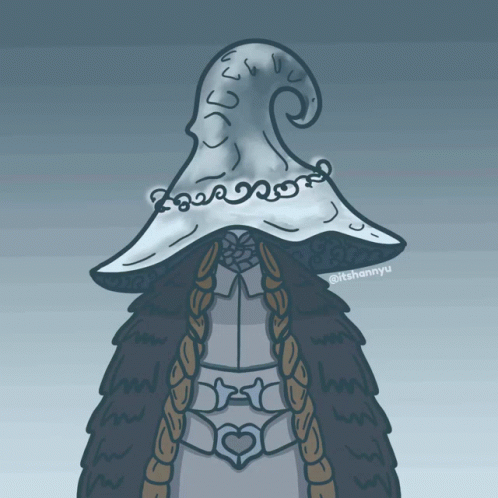Ranni Rule 34

In the world of video gaming, fan art and creative interpretations have become an integral part of the community's engagement and expression. Among the vast array of fan-generated content, Rule 34, a popular internet phenomenon, has gained significant attention. Rule 34 states that "if it exists, there is pornography of it," and it has been applied to various fictional characters, including those from video games. This article delves into the specific case of Ranni, a character from the popular video game Elden Ring, and explores the presence and implications of Rule 34 fan art surrounding her.
The Intriguing Character of Ranni

Ranni, the character in question, is a central figure in the narrative of Elden Ring. She is the daughter of Renna, the Divine Dragon, and plays a pivotal role in the game’s storyline. Ranni’s enigmatic nature, her unique design, and her involvement in the game’s lore have captured the imagination of many players, leading to a surge in fan-created content.
The Rise of Rule 34 Fan Art

Rule 34, often associated with the online community’s creativity and freedom of expression, has led to the production of fan art depicting various characters in explicit or suggestive situations. This trend has not spared Ranni, as artists and enthusiasts have created a diverse range of Rule 34 fan art featuring her.
The Rule 34 fan art surrounding Ranni can be broadly categorized into several themes. One popular theme involves depicting Ranni in intimate or sexual situations with other characters from Elden Ring, often with a focus on her unique physical attributes and the dynamic between the characters. Another theme explores Ranni's potential relationships with characters from other video games or media franchises, creating cross-over fan art.
The Impact and Reception
The reception of Rule 34 fan art featuring Ranni has been mixed. While some fans appreciate the artistic talent and creativity displayed in these works, others find them controversial due to their explicit nature. The line between appreciation of art and objectification of characters is often a subject of debate within the gaming community.
Furthermore, the impact of Rule 34 fan art extends beyond simple entertainment. It can influence the perception and representation of female characters in video games, potentially reinforcing harmful stereotypes or contributing to the sexualization of women in gaming culture. On the other hand, some argue that Rule 34 fan art can also empower female characters by giving them agency and exploring their sexuality on their own terms.
Navigating the Ethics of Fan Art
The existence and popularity of Rule 34 fan art raise important ethical considerations. Creators of such art must navigate the fine line between artistic expression and potential harm. Respecting the boundaries of character representation and considering the impact on the broader gaming community is crucial. Additionally, the potential legal implications of using copyrighted material in fan art should not be overlooked.
For fans and enthusiasts, engaging with Rule 34 fan art requires a critical eye and a commitment to respectful discourse. It is essential to differentiate between appreciation of artistic skill and the endorsement of potentially harmful messages or stereotypes.
The Future of Fan Engagement
As video games continue to evolve and gain mainstream popularity, the role of fan art and community engagement becomes increasingly significant. The existence of Rule 34 fan art surrounding characters like Ranni reflects the passion and creativity of the gaming community. However, it also underscores the need for ongoing dialogue and reflection on the ethical boundaries of fan engagement.
Moving forward, the gaming industry and its fans must work together to create an environment that fosters creativity while respecting the integrity of characters and the diverse experiences of players. This includes promoting diverse representations of characters, encouraging respectful discourse, and supporting artists who push the boundaries of creativity without crossing into harmful territory.
Conclusion
In conclusion, the presence of Rule 34 fan art featuring Ranni from Elden Ring highlights the complex relationship between fan engagement, artistic expression, and ethical considerations. While Rule 34 fan art can be a form of creative outlet and appreciation, it also carries the potential for harm and the reinforcement of negative stereotypes. As the gaming community continues to grow and evolve, it is essential to navigate these complexities with respect, critical thinking, and a commitment to creating a positive and inclusive environment for all players.
What is Rule 34 in the context of fan art and video games?
+Rule 34 is an internet phenomenon that states “if it exists, there is pornography of it.” In the context of fan art and video games, it refers to the creation of explicit or suggestive artwork featuring fictional characters.
Why is Ranni a popular subject for Rule 34 fan art?
+Ranni’s intriguing character, unique design, and pivotal role in the Elden Ring narrative have captured the imagination of many players, making her a popular subject for creative interpretations and fan art.
What are the potential impacts of Rule 34 fan art on gaming culture?
+Rule 34 fan art can influence the perception and representation of female characters in gaming, potentially reinforcing harmful stereotypes or contributing to the sexualization of women. However, it can also empower female characters by giving them agency and exploring their sexuality on their own terms.



